1.8.3 Phase Change
Joey Wu
Phase Change
From Solid to Liquid
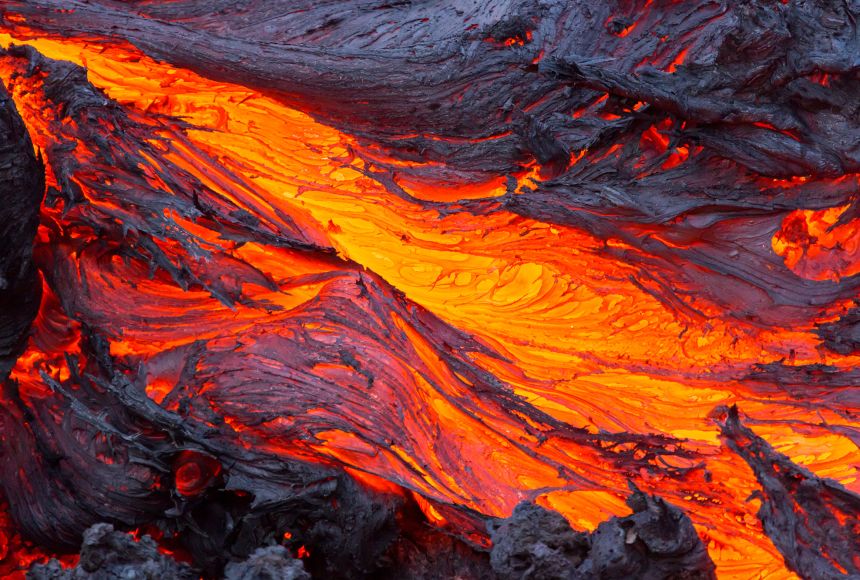
The process in which rocks or other solids change to liquids is called melting. Melting occurs when particles of a solid absorb enough energy to partly overcome the force of attraction holding them together. This allows them to move out of their fixed positions and slip over one another. Melting, like other changes of state, is a physical change in matter, so it doesn’t change the chemical makeup or chemical properties of matter.
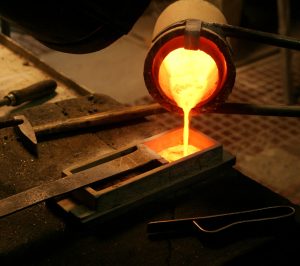
The temperature at which a substance melts is called its melting point. Melting point is a physical property of matter. The gold pictured in the Figure above, for example, has a melting point of 1064°C. This is a high melting point, and most other metals also have high melting points. The melting point of ice, in comparison, is much lower at 0°C. Many substances have even lower melting points. For example, the melting point of oxygen is -222°C.
From Liquid to Solid
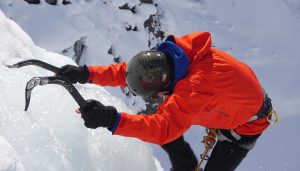
The man in this photo is climbing a glacier. Ice climbing is a dangerous sport that should be attempted only by highly experienced climbers. You don’t have to be an ice climber to enjoy ice. Skating and fishing are two other sports that are also done on ice. What is ice? It’s simply water in the solid state. The process in which water or any other liquid changes to a solid is called freezing. Freezing occurs when a liquid cools to a point at which its particles no longer have enough energy to overcome the force of attraction between them. Instead, the particles remain in fixed positions, crowded closely together, as shown in the Figure below.

From Liquid to Gas
When you heat water, do you ever notice how bubbles begin to form at the bottom and rise to the surface? The bubbles contain water vapor, a gas. As the water heats, it changes from the liquid state to the gaseous state. The change in state of a liquid into a gas is vaporization. The figure below shows two types of vaporization—evaporation and boiling. The two types of vaporization differ in where they take place in the liquid.

Boiling
Vaporization that occurs within a liquid is called boiling. During boiling, vaporization takes place throughout the liquid. The temperature at which boiling occurs in a liquid is called its boiling point. Boiling point is a physical property of matter. The boiling point of pure water is 100°C. Other substances may have higher or lower boiling points. Several examples are listed in the Table below. Pure water is included in the table for comparison.
| Substance | Boiling Point (°C) |
|---|---|
| Hydrogen | -253 |
| Nitrogen | -196 |
| Carbon dioxide | -79 |
| Ammonia | -36 |
| Pure water | 100 |
| Salty ocean water | 101 |
| Petroleum | 210 |
| Olive oil | 300 |
| Sodium chloride | 1413 |
Evaporation
Evaporation also changes a liquid to a gas, but it doesn’t involve boiling. Instead, evaporation occurs when particles at the surface of a liquid gain enough energy to escape into the air. This happens without the liquid becoming hot enough to boil. A small amount of liquid in an open container will disappear after several days due to evaporation. A puddle would disappear the second day due to evaporation too (see figure below).

From Gas to Liquid
Boiling and evaporation are processes that change a liquid to a gas. The opposite process also occurs. When a gas loses enough thermal energy, the gas changes to a liquid, or condenses. The change of state from a gas to a liquid is called condensation. Overnight, water vapor often condenses on blades of grass and forms dew.

From Solid to Gas
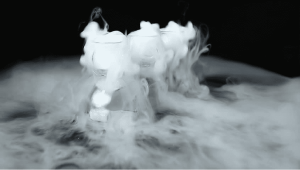
Have you ever seen dry ice used in a science demonstration or to keep food cold during shipping? Unlike regular ice, which melts into a liquid, dry ice undergoes a process called sublimation when it’s exposed to room temperature. Sublimation is the change of state from a solid to a gas without going through the liquid state. As dry ice sublimes, it cools and condenses the water vapor in the surrounding air, creating a thick fog.
From Gas to Solid
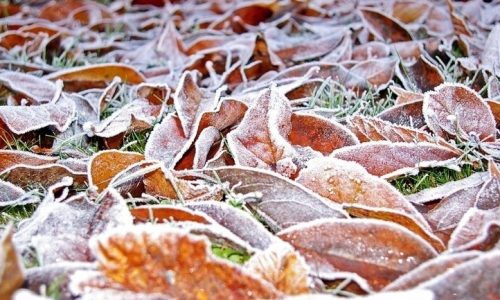
The opposite of sublimation is deposition. Deposition is the change of state of a gas to a solid without going through the liquid state. For deposition to happen, thermal energy must be removed from the gas. Frost on grass and leaves on a fall morning is often the result of deposition. As water vapor loses thermal energy, it changes into solid frost.
Exercises
Type your exercises here.
- Write a sentence that includes an example of one change of state and its opposite process.
-
Happens when thermal energy is added Happens when thermal energy is removed melting ____________ ____________ condensation ____________ ____________ - _________ is the change of state from a solid to a gas without going through the liquid state.
- _________ is the change of state from a gas to a solid without going through the liquid state.
- When enough thermal energy is added, a solid changes to a(n) ___________ ; this process is called __________.
- Name two types of vaporization. How are they different?
Glossary
condensation: the change of state from a gas to a liquid
deposition: the change of state of a gas to a solid without going through the liquid state
evaporation: vaporization that occurs only at the surface of a liquid
kinetic energy: the energy an object has due to its motion
sublimation: the change of state from a solid to a gas without going through the liquid state
temperature: a measure of the average kinetic energy of all the particles in an object
thermal energy: the total potential and kinetic energies of an object
vaporization: the change in state of a liquid into a gas
Sources from: https://flexbooks.ck12.org/user:c1a5964ef3e3/cbook/q205-stem-for-educators/section/2.20/primary/lesson/boiling-ms-ps/
https://www.wrschool.net/cms/lib/AZ02214740/Centricity/Domain/1625/States%20of%20Matter.pdf
Media Attributions
- lava-flow
- Gold-melting-in-Tamil-Nadu
- image_Blanchard_intro21
- Screenshot 2024-09-02 at 11.58.11 PM
- Screenshot 2024-09-03 at 12.00.46 AM
- medium_Disappearing+Puddle
- Morning-Dew-Therapy-scaled
- The-science-behind-dry-ice
- frost-on-leaves

